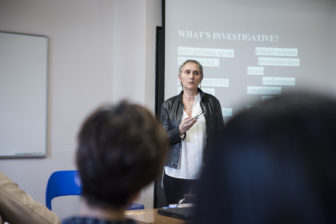Russian version here. Русская версия здесь.
The inverted pyramid is dead – or at least it should be. Susanne Reber, executive editor of Reveal, a public radio show from The Center for Investigative Reporting, says the future of radio lies in long-form storytelling.

Reveal’s Susanne Reber shared tips on Investigative Radio during the 10th Global Investigative Journalism Conference, Johannesburg. Photo: Madelene Cronje
“People said listeners wouldn’t stay tuned in for longer than two or three minutes – they were wrong,” Reber said at an Investigative Radio panel at the 10th Global Investigative Journalism Conference in Johannesburg. “We’re seeing that listeners and journalists are experimenting, and advances in technology are also allowing listeners the freedom of staying with live radio or downloading podcasts,” she added.
Reber also emphasizes delivering a story with depth, rather than getting a scoop, and allowing the source to tell the story, rather than the journalist.
Plot-driven investigative stories with impact are what she calls “the way to keep people from taking an exit ramp,” as a listener stays with the journalist for the full hour of a typical Reveal program.
Spending time mapping out the plot, or developing a story arc, means discipline in structure and character casting, and also becomes an exercise in spotting gaps in stories. It’s why it can take between six to eight weeks to get a story to air once reporters’ tapes are in, according to Reber.
For reporter Kwetey Nartey of Joy FM in Ghana, who shared the panel with Reber, story preparation begins before getting into the field. Nartey spent a week with rebels, pretending to be a foreign student researching illegal mining. He was reporting a high-risk story on illegal gold mining that may be funding rebels in Bole, north of Accra.
“It is all about the planning and making sure you have ticked every checklist,” said Nartey. It’s also about attention to detail, because one false step could be not just the end of your story, but the end of your life, he said.
For Nartey that meant making mock student cards, using unobtrusive recorders attached to the inside of a motorbike helmet and recording as much audio as possible so he could have a solid body of evidence once back in his newsroom.
“You cannot get it right 100 percent of the time, but you can minimize mistakes by anticipating risks and by planning as much as possible.”
Pro Tips for Crafting the Narrative Investigative Radio Story:
- Get audio from a source at different intervals, not just at the ‘reveal’ moment in a story. This will give you banked recordings that depict the unfolding action of a story in an authentic way.
- Ask sources for any additional documents they may have but may not think are relevant.
- Plot and plan, but be flexible in how the story and the characters may change.
- Think in sound when you’re talking big numbers and big data, by using an image of scale, for example.

Ufrieda Ho is a freelance journalist based in Johannesburg. She is the author of Paper Sons and Daughters.
 Madelene Cronjé is an independent photographer based in Johannesburg, South Africa. Formerly a staff photographer at the Mail and Guardian, she specializes in photojournalism and editorial portraiture.
Madelene Cronjé is an independent photographer based in Johannesburg, South Africa. Formerly a staff photographer at the Mail and Guardian, she specializes in photojournalism and editorial portraiture.
